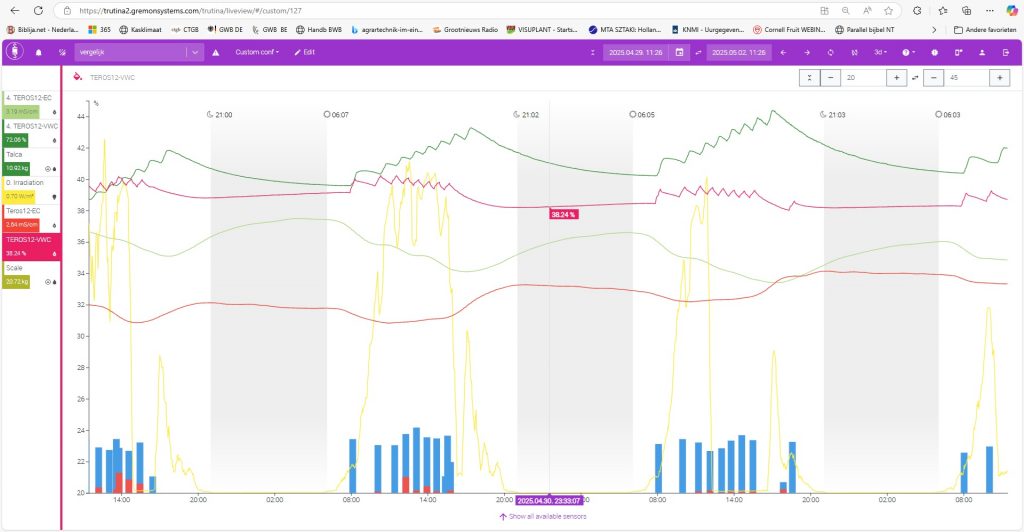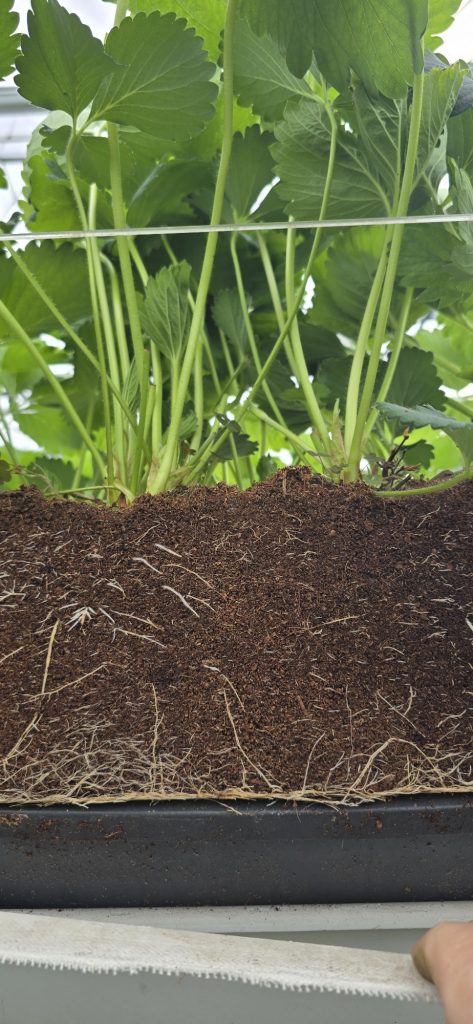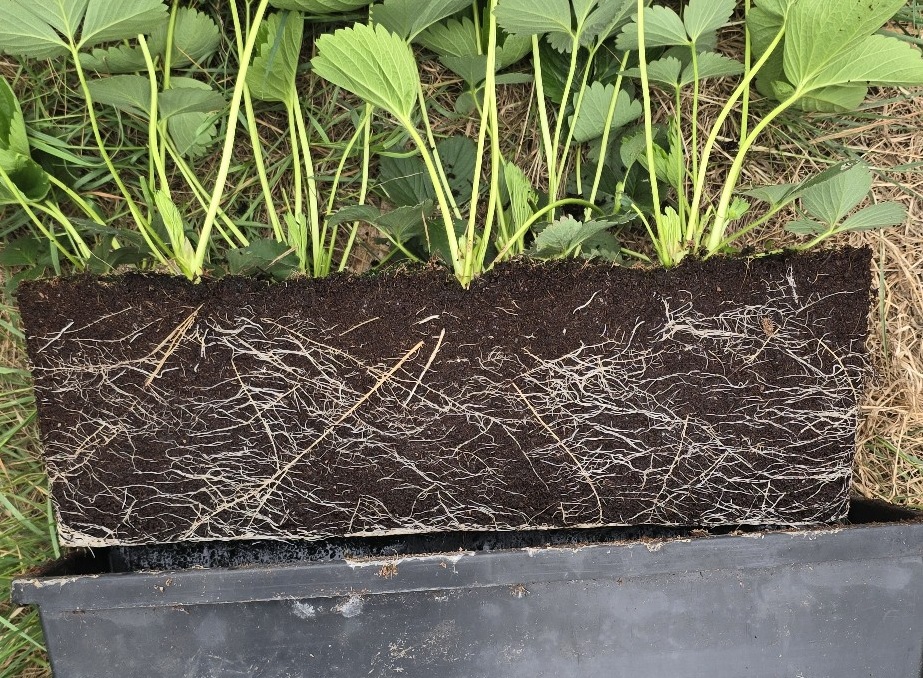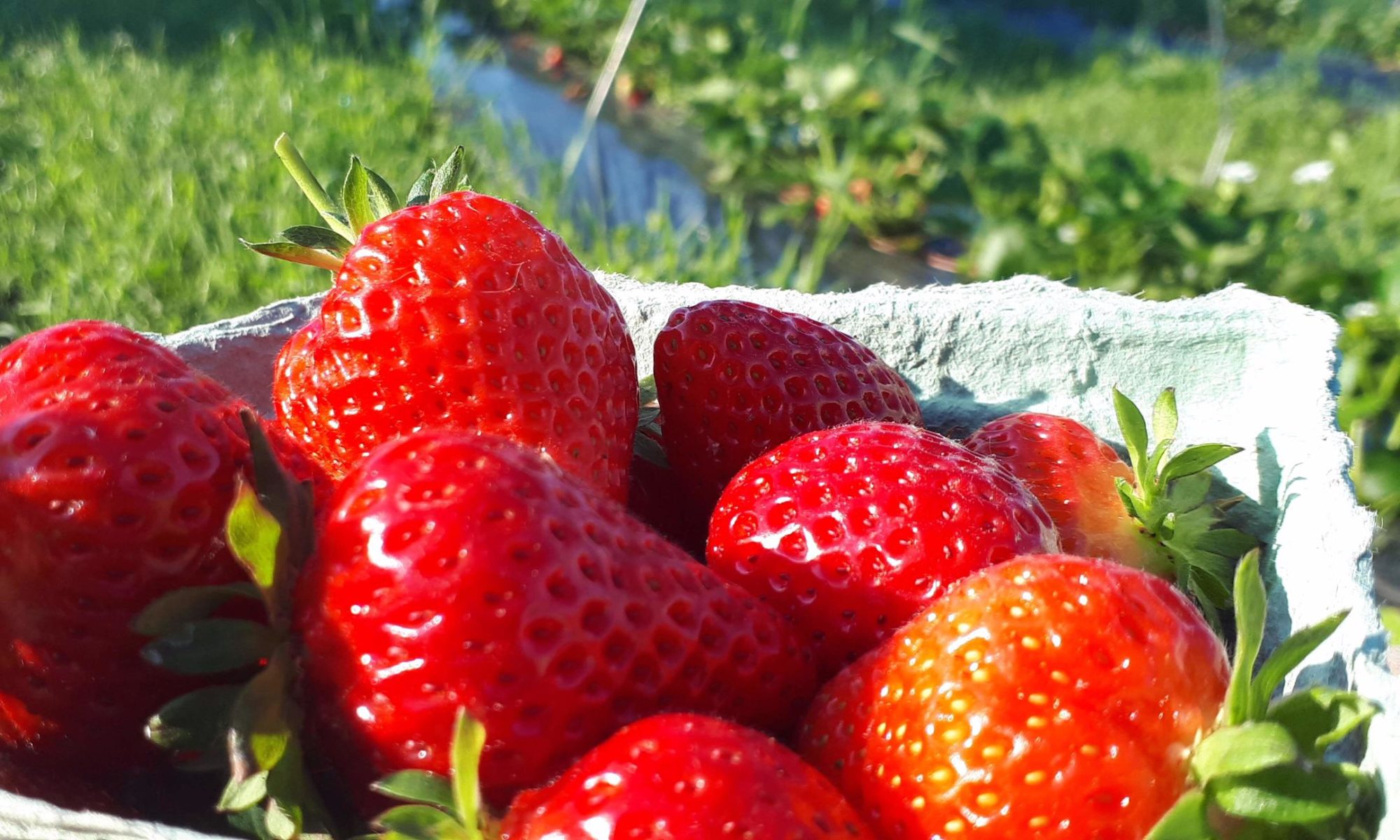In the past i have written more about irrigation. Most growers experience it as one of the hardest subjects of growing strawberries. There are so many links to the growth:
– Vegetative / Generative growth balance
– Rooting
– Quality of the strawberries (tast, firmness, skin quality and sensitivity)
– Production
But it also direct connects to EC / Feed, Diseases (leaf and root diseases), Tipburn.
Every reason to just do it good, if possible at all.
A few basics of irrigation:
– direct relation between evaporation and radiation (more radiation = more uptake)
– there is no irrigation system 100% perfect, therefore we need drain to compensate those mistakes
– drain is also needed to flush balast salts or too high EC

Above you see different irrigation graphs.
Green:
dark green – moisture content grower 1
ligh green – EC grower 1
Reddish:
purple – moisture content grower 2
light green – EC grower 2
Yellow: radiation (Watt/m2)
Bar graph:
blue: irrigation amount
red: drain water
In green a nice irrigation: moisture content is increasing over de day and decreasing in night time. The green line below it is the EC, which is stable or a bit decreasing.
Irrigation from the other grower is in red/purple. There you can see a quite stable or even slightly decreasing moisture content. This in combination with the EC increasing.
In the bar graph below blue = the irrigation, red is the drain. It is clearly visible that there is only just a bit of drain, not enough to even out mistakes or flush high feed contents.
Normal drain percentages for full grown crops:
– Sunny weather: 30-40%
– Half cloudy: 15-25%
– Cloudy, rainy: 5-15%
Normal dry – down:
– between sunrise and first irrigation: 0,5-1,5%
– between last irrigation and sunset: 1-2%
– between last irrigation and the first irrigation next morning: 3-6%
– lower dry downs is more vegetative growing, higher dry downs is more generative growing.
Rooting paterns are direct influenced by the way you irrigate:

– dry growing: roots mainly in the lower 25% of the substrate
– wet growing: roots higher in the substrate and less in the bottom 10% of the substrate
– good growing: roots everywhere but in the top 2 cm of the substrate
– irregular irrigation: white and brown roots
On the left side dry growing: roots on the bottom and not enough roots in the rest of the substrate

In order to know if you are on track, drain% are one of the ways to check it, as mentioned above. The other things that is really important is that the irrigation is stable. Therefore we have a check mechanism: ml/joule (or officially: ml/m2 / joule/cm). This should be quite stable:
– between the irrigations of the day
– stable between the days. It should also be almost the same on a dark cloudy day as on a bright sunny day.
If you take care of this irrigation being stable, and the drain percentages are correct, you normally have a good rooting crop, like you can see in the picture above.
The best way to get this stable is by using the irrigation based on radsum, and not or almost not limited by time (min time or max time). Most growers i visit i advice to set the max time on about 6 hours and the min time on about 10-15 minutes.
Strawberry quality issues are mainly the consequence of irrigation, high EC or recipe.
Irrigation:
– big deviations in ml/joule within the day or between the days, causing roots sometimes to be dry, sometimes to be water soaked.
– too much irrigation in warm, very humid days or evenings may cause root pressure issues: fruits getting soft because they collapse.
High EC:
– too high EC gives a hard water uptake and a bad uptake of for example calcium causing softer fruits
Recipe:
– high ammonium, too high or too low potassium may cause soft fruits.
– therefore take frequent drain and irrigation water samples and have them analized.
Production
There is a direct correlation between water uptake and production. If the water uptake of a crop slows down, production (total production = leafs, flowers, strawberries, roots) drops. We need al these in order to get a good fruit production.
You want your water uptake to be paralel to the radiation (watt/m2). If that is correct, irrigation seems to be good. If the water uptake is influenced by your irrigation (increase in water uptake right after an irrigation), the water uptake and evaporation was limited by the water content in the substrate – thus limiting production and/or quality.

